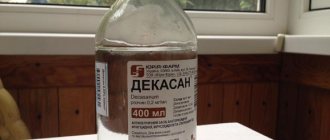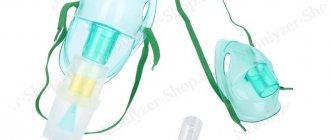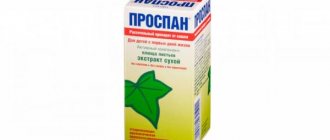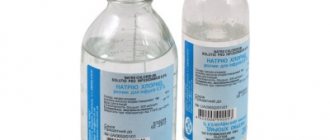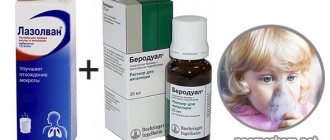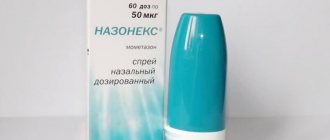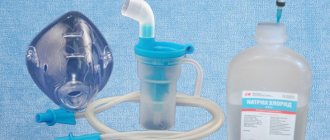How to do inhalations with Pulmicort correctly
Dosed suspension is sold in transparent containers. The drug belongs to glucocorticosteroids. Prescribed for diseases of the respiratory system accompanied by tissue swelling and inflammation. It has a pronounced anti-allergic, anti-inflammatory, anti-edematous effect. Additionally, it reduces coughing attacks, reduces mucus production, and promotes its elimination. The medication is prescribed as an independent remedy and as part of complex therapy.
Pulmicort or Berodual - which is better?
The drugs under consideration belong to different pharmacological groups. Pulmicort is a glucocorticosteroid (GCS), and Berodual belongs to bronchodilators that expand the lumen of the bronchi and relax their smooth muscles.
Berodual does not have anti-allergic and anti-edematous effects, and its anti-inflammatory effect is weaker than that of Pulmicort. Berodual is often used before the administration of inhaled medications.
In general, you should not compare Berodual and Pulmicort; each drug has its own composition, mechanism of action and purpose.
Both drugs are aimed at relieving attacks of bronchial obstruction and preventing the development of severe attacks of bronchial asthma.
The following question is often found on Internet pages: “Is it possible to mix Pulmicort with Berodual for inhalation?” These drugs are potent drugs, so it is not advisable to use them in one mixture, especially in pediatric practice. Usually Berodual is prescribed first, and if there is no effect, Pulmicort is used. This scheme is practiced by ambulance crews.
In any case, only a doctor will tell you the necessary remedy, its dose and inhalation regimen.
Complete instructions on the use of Berodual for inhalation.
Berodual inhalations for children - personal experience
Features of application
Pulmicort is a hormonal drug, so the dosage is selected individually. There are several criteria for dose selection:
- age, if the drug is prescribed to children;
- body weight, if used for infants;
- severity, nature of the disease.
It is administered into the body using a nebulizer or compressor inhaler. According to the instructions for use, it should not be poured into a steam device. Not recommended for use in a mesh nebulizer. In order for inhalations with Pulmicort to work properly, you need to use the appropriate equipment.
A compressor nebulizer sprays the medicine into an aerosol. Small particles enter the lower respiratory organs and are localized in pathological places. Larger droplets settle on the surface of the upper respiratory tract. If used incorrectly, Pulmicort for nebulizer causes side effects, therefore, independent measures without consultation with specialists are not allowed.
Indications
The active ingredient is budesonide. Refers to glucocorticosteroid substances with pronounced antiallergic, anti-edematous, anti-inflammatory effects. According to the instructions for use, Pulmicort for inhaler is prescribed for:
- bronchial asthma requiring treatment with hormonal drugs;
- false croup or steroid laryngotracheitis;
- COPD
In addition, the drug is prescribed to children and adults for complex bronchitis and tracheitis. Additional properties of inhalations with Pulmicort are reducing the formation of sputum, improving its discharge, and normalizing the functions of the respiratory organs.
Interaction with other drugs
Important information:
- combined use with Ketoconazole increases plasma concentrations up to 6 times. To prevent pronounced effects and side effects, it is recommended to lengthen the interval between the use of Ketoconazole and inhalations with Pulmicort;
- the use of Itroconazole also affects plasma concentrations. Follow the recommendations as when interacting with Ketoconazole;
- simultaneous use of Phenytoin, Phenobarbital, Rifampicin and Pulmicort reduces the activity of budesonide;
- To enhance the effects of Pulmicort, doctors advise inhalation using beta-adrenergic stimulants, then using a drug based on budesonide.
Find out the program for preparing children for school at home.
The development and routine of a child at 3 months is written at this address.
Follow the link and read about the diagnosis of pulpitis in primary teeth and its treatment.
Take note:
- a hormonal agent for inhalation in the form of a powder or suspension is prescribed only by a pulmonologist. The doctor will show you how to dilute the drug and how to use a nebulizer;
- take into account the doctor’s recommendations, buy a compressor nebulizer, especially if the child has bronchial asthma. Inhalations with Pulmicort will relieve the child of suffering during attacks that often occur at night;
- The modern device is also useful during the treatment of diseases of the bronchi and lungs.
READ ALSO: Complex probiotic product for restoring normal microflora of children's intestines - Bifiform Baby: instructions for use of a series of medicinal products
How often can inhalations be done?
The duration of the course is determined by a specialist. Depends on the age of the patient and the complexity of the disease. If the medication is prescribed at a dose of 1 mg per day, inhalation is done only 1 time per day. When prescribing high doses, divide them into 2 doses. The interval between inhalations is at least 2 hours. With a long course of therapy, one procedure is usually done in the morning, the second in the evening. If it is necessary to administer a large dose at the same time, take a break of 30 minutes between breathing measures.
Inhalation lasts as many minutes as it takes to fully use the medicine. If medication remains in the nebulizer cup, it means that not the entire dose of active substances has entered the body. The therapeutic effect is reduced. The duration of the course of treatment is from 3 days to 10.
How to inhale pulmicort for a child
In childhood, the drug is prescribed with caution; the regimen for its use will largely depend on the patient’s condition and his age. In order to neutralize the acute condition, accompanied by hoarseness, severe and prolonged cough, special inhalations may be required, which are carried out in the morning and evening. It is highly recommended to do this for 72 hours straight. As primary therapy, it is recommended to prescribe the drug for a long period of time. Next, I would like to draw your attention to the following:
- for laryngitis, bronchitis in a child, the medicinal name can be used for a short time, it is advisable to do this as an emergency measure for 2-3 days;
- Inhalation of Pulmicort for faster secretion of sputum can be alternated with saline solution (the price of which is more than affordable);
- if it is necessary to provide emergency treatment, attacks of shortness of breath should be relieved with names such as Berodual and Pulmicort ;
- inhalations are carried out in turns, in this case there must be a mandatory interval of 20 minutes.
Detailed instructions for inhalation of Pulmicort and Berodual.
First, you need to take care to neutralize the spasm with Berodual, after which inhalation is carried out using Pulmicort. According to reviews, the presented drug for treatment in childhood can help after the very first session; it is also well tolerated by children and rarely provokes complications. The likelihood of the development or absence of side effects in children deserves special attention.
How to do inhalations with Pulmicort correctly
According to the instructions for use, breathing procedures should be carried out on an empty stomach or half an hour after a meal. However, if there is an urgent need to administer the medicine, inhalation is done at any time.
It is recommended to inhale the medicine, according to the instructions for use, through a mouthpiece, but children are allowed to use masks. Breathing should be smooth and deep. With frequent breathing, dizziness occurs and the cough intensifies. You should inhale through your mouth and exhale through your nose. After the procedure, you should not eat for 2 hours, or go outside in any weather.
Possible negative reactions to the use of pulmicort
Taking Pulmicort can cause growth retardation in a child. However, as soon as the doctor stops this remedy, normal development is restored. In general, negative reactions are more likely to occur in adults who have been prescribed an overdose. In addition, in rare cases, the following negative reactions occur:
- irritation of the throat area;
- candidiasis and a feeling of dryness in the mouth;
- bronchospasms;
- pain in the head;
- dry cough;
- allergic response of the body.
Important: Doctors do not recommend using pulmicort frequently, since there is a high risk of developing adrenal hyperfunction.
There are also cases where children experienced overexcitement, development of depression and malaise. In addition, using an inhaler may cause a rash on the skin and bruising.
Do not miss useful information: Instructions for use of Flixotide for inhalation
Pulmicort for children: application features
Many parents, whose children often suffer from acute respiratory diseases (ARI), actively use inhalation at home. Inhalation, especially using a nebulizer, is an effective method of treating and preventing infectious and allergic diseases of the respiratory tract. Their main advantages are:
- ease of use;
- fast action;
- lack of influence on other organs and systems;
- Possibility of use for various diseases;
- setting the exact dosage of the drug and the absence of overdoses in this regard.
Inhalations can be carried out with various medications. The most popular for inhalation are glucocorticoids. Among them, a drug such as Pulmicort is actively used.
Pulmicort is a medicine that is used to treat obstructive diseases of the lungs and respiratory tract. The glucocorticosteroid budesonide is the main active ingredient of the drug Pulmicort. Can children use this medication? Yes. As indicated in the instructions, Pulmicort is used for children from 6 months.
Pulmicort for children is available in the form of a powder, from which a solution for inhalation is prepared, and also in the form of nebulas. Nebulas are small plastic ampoules containing a medicinal substance. Pulmicort for children in nebulas and in powder for solution is used using a special device - a nebulizer. The use of Pulmicort in children in a nebulizer involves spraying the medicine into the lungs through a mouthpiece or mask. The latter are connected via a tube to a chamber for the medicine and a device that pumps up pressure. This nebulizer device allows even the smallest children to safely carry out inhalations at home.
What effect does Pulmicort have on the children’s body, for what diseases is it used and how is this medicine used correctly for children?
Instructions for use of pulmicort
We have already become familiar with the indications for the use of pulmicort - these are bronchial asthma that requires hormonal support and obstructive bronchitis with a chronic course. The drug can also be used to relieve false croup in children.
When is pulmicort contraindicated?
The drug is not used until six months of age and in cases where the child has an individual intolerance to the active substance (budesonide).
Pulmicort also has relative contraindications, they are as follows:
- viral infections;
- bacterial damage to the body;
- tuberculosis (if Koch bacilli are present in the sputum) – active phase of the disease;
- fungal pathologies;
- cirrhosis of the liver.
At large doses of pulmicort, the drug exhibits a systemic effect, which leads to the appearance of various adverse symptoms.
Composition, release form, storage and price
The main active ingredient of the Swedish drug Pulmicort is budesonide, a glucocorticosteroid for topical use.
Pulmicort (suspension) for inhalation has dose packs of 0.25 mg/ml and 0.5 mg/ml. Each container contains 2 ml of the drug. There are 5 containers connected to each other on one sheet. They easily come apart from each other.
The drug is stored at a temperature of no more than 30°C. After opening the envelope containing the containers with pulmicort, the medicine must be consumed within 3 months. An opened container is stored for no more than 12 hours. A mandatory condition for storing the drug is protection from sunlight and normal indoor air humidity.
The price of pulmicort for inhalation is in the range of 900 – 1300 rubles. A dosage of 0.25 mg/ml usually does not exceed 1000 rubles, and a dose of 0.5 mg/ml, on the contrary, more than 1000 rubles. Most parents consider the product expensive, so we will consider cheaper analogues.
How does pulmicort work?
Budesonide, the main component of the drug, exhibits decongestant, antiallergic and anti-inflammatory activity. Pulmicort 0.25 and 0.5 for inhalation reduces the frequency and intensity of attacks in children, and also helps reduce the production of sputum and mucus in the tracheobronchial tree.
When performing inhalations with pulmicort for a dry cough and difficult to separate sputum, the bronchi are cleansed, the inflammatory reaction and hyperactivity of the airways are relieved, and this, in turn, is necessary to prevent the development of attacks and obstruction in COB.
How to dilute Pulmicort for inhalation?
The form for inhalation (container) is already thought out in itself. Parents do not need to carry out long manipulations mixing powders with solvents. The main thing is to know how to dilute pulmicort for children, because... doses for therapeutic inhalations are very important; the effectiveness and safety of the child’s treatment depends on this.
To carry out inhalations you will need a special device - a nebulizer . This is a modern device where the medicine is placed, and the child easily takes the necessary treatment by inhaling healing vapors.
For each small patient, a pediatric pulmonologist selects a therapeutic dose. Typically, children from 6 months of age are prescribed up to 0.5 mg of the drug per day, but if the frequency and duration of attacks is high, the dose is increased to 1 mg. Such dosages allow the procedure (inhalation) to be carried out once a day. At higher doses, treatment is divided into several inhalations.
For proper use of pulmicort, parents must know the correspondence of the dose in milligrams to the volume of the suspension in milliliters. So, 0.25 mg = 1 ml, 0.5 mg = 2 ml, 0.75 mg = 3 ml, 1 mg = 4 ml.
Pulmonologists often prescribe pulmicort for inhalation in its pure form, i.e. without diluting the drug, although the instructions for use advise the following: “pulmicort should be diluted with 0.9% sodium chloride solution to a volume of 2 ml.” In practice, a 1:1 dilution of pulmicort with saline is often used.
An important aspect of treatment remains the selection of the minimum and effective therapeutic dose for each child.
Interesting - Rules for inhalation at home.
What side effects can cause inhalation with Pulmicort?
Side effects occur in 10% of all cases of pulmicort use.
Firstly, this drug contains a hormone, and its long-term use reduces immune defense, and secondly, like any other drug, budesonide (the active substance) can cause individual pathological reactions. These may be the following disorders: fungal infection of the oropharynx, nausea, hoarseness, dry mouth, changes in the central nervous system (excitability, depression), angioedema, skin rashes, and others.
Important! To minimize the occurrence of unpleasant reactions after inhalation, it is necessary to force the child to thoroughly rinse the growth with boiled water. It is also recommended to wash your face where the mask touches.
Pulmicort: indications for children
The active substance of Pulmicort, budesonide, is a synthetic analogue of the adrenal hormone, which regulates water and salt metabolism in the body. Thanks to budesonide, Pulmicort expands the lumen of the bronchi, improves the respiratory function of the lungs, and has an anti-inflammatory and antiallergic effect on the child’s body. This drug is well tolerated and causes virtually no side effects.
Pulmicort for inhalation is used for children:
- with bronchitis;
- with laryngitis;
- when coughing, including dry cough;
- for bronchial asthma;
- with vasomotor rhinitis;
- for allergic rhinitis;
- to prevent the growth of polyps in the nasal cavity after their removal (polypectomy).
Instructions for use of Pulmicort for children are simple and will not create difficulties for parents. The medicine is easy to dilute, and inhalation of the medicine is quick and painless.
Analogues of the drug
If necessary and only after additional consultation with your doctor, Pulmicort can be replaced with other medications. These include:
- Ventolin is a drug based on salbutamol, a bronchodilator, which is used to relieve attacks of bronchial asthma and treat obstructive bronchitis that is not responsive to other drugs. Ventalin for inhalation is considered stronger than Pulmicort, but at the same time it has a more aggressive effect on other systems and organs, and can also lead to the development of serious side effects, including those from the cardiovascular system. According to the instructions, inhalations with Ventolin can be given to children starting from the age of four. Inhalation of infants or children aged 1-3 years is possible only under medical supervision. In most pharmacies the drug is sold by prescription. The average price of a package (20 nebulas) is 260 rubles.
- Benacort . The main active ingredient of the drug is budesonide. The medicine is intended to relieve attacks of bronchial asthma, but does not relieve obstruction due to bronchitis. Benacort is strictly prohibited for use under 16 years of age. Purchasing the drug is currently difficult due to its lack of availability in pharmacy chains.
- Berodual is a non-hormonal drug based on ipratropium bromide. Indicated for use in obstructive pathologies of the respiratory system. It can be used to treat patients of all age categories, but inhalations for infants are carried out only in a hospital setting. It is often practiced to combine inhalations with Berodual with Pulmicort according to the regimen recommended by the doctor - such therapy is justified in severe cases with severe respiratory dysfunction. The average price of a bottle (20 ml) is 276 rubles.
Average price of a bottle (20 ml) – 276 rubles
How it works
Pulmicort (active ingredient - budesonide) is an anti-inflammatory drug of hormonal origin, which is used for obstructive laryngitis, bronchitis, and asthma.
It is used by inhalation - this provides a quick and effective effect on the source of inflammation.
Budesonide is a glucocorticoid (derived from adrenal steroid hormones) drug that has anti-inflammatory, antiallergic and immunosuppressive effects.
Budesonide inhibits the synthesis of inflammatory mediators; in this case, there is a decrease in edema, expansion of the lumen of the bronchi and larynx.
Important! Pulmicort is available from pharmacies with a prescription. It should be used only as prescribed by a doctor.
Use for obstructive form
Acute obstructive laryngitis (croup) occurs in children aged from 0.5 to 6 years. It manifests itself as a spastic narrowing of the lumen of the larynx and, as a result, a “barking” cough, whistling, difficulty breathing and hoarseness of voice (up to its complete disappearance).
Pulmicort can be an emergency treatment for croup : before the doctor arrives, you need to take one inhalation with the drug (the dosage will be discussed below). In the future, pulmicort can be used as a supportive agent. The effectiveness of glucocorticosteroids (including pulmicort) in the treatment of croup has been proven by medical research.
For inhalations
For inhalation with pulmicort, a nebulizer with a mask is used (it is needed if the child cannot inhale on his own) and a mouthpiece. The nebulizer does not have to be ultrasonic . For inhalation, a compression nebulizer is used.
Before use, shake the container with the drug. It should be held vertically. Then the container must be placed with the open end into the nebulizer and the drug must be carefully squeezed out.
On a note! An opened container with suspension is stored for no more than 12 hours from the moment of opening in a cool, dark place.
After the procedure, you need to rinse the child’s mouth with a soda solution - this will help avoid fungal (candida) infection of the mucous membrane. To avoid irritation on your facial skin due to the nebulizer mask, you need to wash your face after the procedure.
After inhalation, you also need to rinse the nebulizer (chamber, mask and mouthpiece) with a special product (detergent) specified in the instructions for the device.
Dosage
For children, the dosage of pulmicort is prescribed by the doctor individually depending on:
- age,
- concomitant diseases,
- general condition,
- nature of the disease.
Children over 6 months of age (the drug cannot be used at an earlier age) are prescribed an initial dose of 0.25-0.5 mg per day. In some cases, the dose is increased, but it should not exceed 1 mg of the drug per day.
Maintenance therapy is carried out using doses of 0.5 to 2 mg per day. According to the instructions, the drug must be diluted with saline solution (0.9% sodium chloride solution or table salt).
The number of inhalations per day is determined as follows:
- Dose less than 1 mg/day – 1 inhalation in the evening,
- Dose more than 1 mg/day - 2 inhalations (morning and evening).
Also, for a therapeutic effect, a pulmicort suspension is sometimes mixed with:
- terbutaline,
- sulbutamol,
- acetylcysteine (ACC),
- sodium cromoglycate (intal),
- ipratropium bromide (Atrovent, Ipravent).
Video about Pulmicort dosage:
Rules of application
When treating laryngitis in children with pulmicort, the following should be considered:
- to relieve an acute condition, inhalations are done for 3 days, 2 times: in the morning and in the evening,
- to enhance the effect of pulmicort, you can alternate it with inhalation of saline solution,
- the drug has a number of side effects, so it should not be used without consulting a doctor.
Pulmicort interacts with some other drugs: they either enhance or weaken its effect.
Strengthen:
- Estrogens,
- Beta-agonists,
- Methandrostenolone.
Weaken:
In what form is it released?
This solution can be purchased in several forms:
- nebulas 0.25 and 0.50 mg/ml;
- ampoules of 2 ml;
- in powder form, in dosage per 100 or 200 doses. In addition, you can find a dosage of 125 mg in pharmacies.
Don't miss useful information: Borjomi for inhalation in a nebulizer: step-by-step instructions
Given the variety of release forms of this drug, before using it, you should get advice and a prescription from your doctor.
Contraindications and side effects
Pulmicort should not be used if the child is under 6 months of age or has a hypersensitivity to budesonide. The medicine is used with caution and under the strict supervision of a doctor in the presence of respiratory tract infections of various etiologies and liver diseases.
Side effects:
- Common : cough, dryness and irritation of the mucous membrane of the mouth and throat, candidiasis (fungal infection) of the oropharynx,
- Rarely : skin bruising, bronchospasm, depression, rash, contact dermatitis, urticaria, nausea,
- Very rarely, negative systemic effects of the drug occur (decreased bone density, glaucoma, cataracts, growth disorders).
